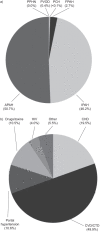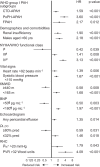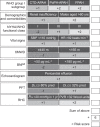REVEAL: a contemporary US pulmonary arterial hypertension registry
- PMID: 22379169
- PMCID: PMC9487467
- DOI: 10.1183/09059180.00008211
REVEAL: a contemporary US pulmonary arterial hypertension registry
Conflict of interest statement
M.D. McGoon's institution has received research funding from Medtronic and Gilead for studies related to pulmonary hypertension in which he was primary investigator. He has served on advisory, steering and/or endpoint/DSMB committees for Actelion, Gilead, Lung LLC, GSK and Medtronic. He has received honoraria for speaking at conferences supported by Actelion and Gilead. D.P. Miller is an employee of ICON Late Phase and Outcomes Research, a division of ICON PLC. His department receives research funding from pharmaceutical companies to conduct observational research. Funding for the statistical analysis of the REVEAL study is provided by Actelion. No funding was provided for his participation in this manuscript.
Figures








Similar articles
-
The changing picture of patients with pulmonary arterial hypertension in the United States: how REVEAL differs from historic and non-US Contemporary Registries.Chest. 2011 Jan;139(1):128-37. doi: 10.1378/chest.10-0075. Epub 2010 Jun 17. Chest. 2011. PMID: 20558556 Clinical Trial.
-
Epidemiology of pulmonary arterial hypertension.Clin Chest Med. 2013 Dec;34(4):619-37. doi: 10.1016/j.ccm.2013.08.010. Epub 2013 Oct 18. Clin Chest Med. 2013. PMID: 24267294 Review.
-
An evaluation of long-term survival from time of diagnosis in pulmonary arterial hypertension from the REVEAL Registry.Chest. 2012 Aug;142(2):448-456. doi: 10.1378/chest.11-1460. Chest. 2012. PMID: 22281797
-
Registry and survival study in chinese patients with idiopathic and familial pulmonary arterial hypertension.Chest. 2007 Aug;132(2):373-9. doi: 10.1378/chest.06-2913. Epub 2007 Mar 30. Chest. 2007. PMID: 17400671
-
World Health Organization Group I Pulmonary Hypertension: Epidemiology and Pathophysiology.Cardiol Clin. 2016 Aug;34(3):363-74. doi: 10.1016/j.ccl.2016.04.001. Cardiol Clin. 2016. PMID: 27443134 Free PMC article. Review.
Cited by
-
Characteristic disease defects in circulating endothelial cells isolated from patients with pulmonary arterial hypertension.PLoS One. 2024 Oct 28;19(10):e0312535. doi: 10.1371/journal.pone.0312535. eCollection 2024. PLoS One. 2024. PMID: 39466801 Free PMC article.
-
Chronic thromboembolic pulmonary hypertension: the diagnostic assessment.Front Cardiovasc Med. 2024 Sep 6;11:1439402. doi: 10.3389/fcvm.2024.1439402. eCollection 2024. Front Cardiovasc Med. 2024. PMID: 39309600 Free PMC article. Review.
-
An electrocardiogram-based AI algorithm for early detection of pulmonary hypertension.Eur Respir J. 2024 Jul 25;64(1):2400192. doi: 10.1183/13993003.00192-2024. Print 2024 Jul. Eur Respir J. 2024. PMID: 38936966 Free PMC article.
-
"This Patient Needs a Doctor, Not a Guideline!" The Zone of Uncertainty in Pulmonary Arterial Wedge Pressure Measurement.Am J Respir Crit Care Med. 2024 Sep 15;210(6):712-714. doi: 10.1164/rccm.202402-0359VP. Am J Respir Crit Care Med. 2024. PMID: 38668713 Free PMC article. No abstract available.
-
Pulmonary Hypertension in Women.Methodist Debakey Cardiovasc J. 2024 Mar 14;20(2):70-80. doi: 10.14797/mdcvj.1308. eCollection 2024. Methodist Debakey Cardiovasc J. 2024. PMID: 38495664 Free PMC article. Review.
References
-
- Rich S, Dantzker DR, Ayres SM, et al. . Primary pulmonary hypertension: a national prospective study. Ann Intern Med 1987; 107: 216–223. - PubMed
-
- Rich S, ed. Executive summary from the World Symposium on Primary Pulmonary Hypertension 1998. Evian, September 6–10, 1998. Co-sponsored by the World Health Organization.
-
- Simonneau G, Galiè N, Rubin L, et al. . Clinical classification of pulmonary hypertension. J Am Coll Cardiol 2004; 43: Suppl. 12, S5–S12. - PubMed
-
- Simonneau G, Robbins IM, Beghetti M, et al. . Updated clinical classification of pulmonary hypertension. J Am Coll Cardiol 2009; 54: Suppl. 1, S43–S54. - PubMed
-
- Stricker H, Domenighett G, Popov W, et al. . Severe pulmonary hypertension: data from the Swiss Registry. Swiss Med Wkly 2001; 131: 346–350. - PubMed
Publication types
MeSH terms
LinkOut - more resources
Full Text Sources
Other Literature Sources
Medical
